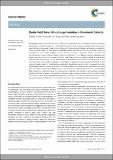Files in this item
Dipole field driven morphology evolution in biomimetic vaterite
Item metadata
| dc.contributor.author | Greer, Heather Frances | |
| dc.contributor.author | Liu, Ming-Han | |
| dc.contributor.author | Mou, Chung-Yuan | |
| dc.contributor.author | Zhou, Wuzong | |
| dc.date.accessioned | 2017-01-28T00:32:31Z | |
| dc.date.available | 2017-01-28T00:32:31Z | |
| dc.date.issued | 2016-03-07 | |
| dc.identifier | 240588318 | |
| dc.identifier | 03bd1b18-85d2-42c4-8fe2-d6c744e9de4c | |
| dc.identifier | 84959010854 | |
| dc.identifier | 000371233900014 | |
| dc.identifier.citation | Greer , H F , Liu , M-H , Mou , C-Y & Zhou , W 2016 , ' Dipole field driven morphology evolution in biomimetic vaterite ' , CrystEngComm , vol. 18 , no. 9 , pp. 1585-1599 . https://doi.org/10.1039/C5CE02142A | en |
| dc.identifier.issn | 1466-8033 | |
| dc.identifier.other | ORCID: /0000-0001-9752-7076/work/58055083 | |
| dc.identifier.uri | https://hdl.handle.net/10023/10191 | |
| dc.description.abstract | Morphology evolution is an important process in naturally occurring biominerals. To investigate the interaction between biomolecules and inorganic components in the construction of biominerals, biomimetic hexagonal prism vaterite crystals were hydrothermally prepared through a reaction of urea with calcium nitrate tetrahydrate, whilst gelatin was added as a structure directing agent. An extraordinary morphology evolution was observed. The time dependent growth was investigated by using X-ray diffraction, scanning electron microscopy, transmission electron microscopy and thermogravimetric analysis. In the early stages, vaterite nanocrystallites, ~5 nm in diameter, underwent aggregation with gelatin molecules and precursor molecules into 50 nm sized clusters. Some nanoneedles, consisting of self-orientated nanocrystallites embedded within a soft gelatin matrix, were developed on the surface of disordered cores to form spherulite particles, with a similar morphology to natural spherulite biominerals. Further growth was affected by the high viscosity of gelatin, resulting in ellipsoid particles composed of spherulitically ordered needles. It is proposed that surface adsorbed gelatin induces the formation of dipoles in the nanocrystallites and interaction between the dipoles is the driving force of the alignment of the nanocrystallites. Further growth might create a relatively strong and mirror-symmetric dipolar field, followed by a morphology change from ellipsoidal with a cell-division like splitting, to twin-cauliflower, dumbbell, cylindrical and finally to hexagonal prism particles. In this morphology evolution, the alignment of the crystallites changes from 1D linear manner (single crystal like) to 3D radial pattern, and finally to mirror symmetric 1D linear manner. This newly proposed mechanism sheds light on the microstructural evolution in many biomimetic materials and biominerals. | |
| dc.format.extent | 2898596 | |
| dc.language.iso | eng | |
| dc.relation.ispartof | CrystEngComm | en |
| dc.subject | QD Chemistry | en |
| dc.subject | NDAS | en |
| dc.subject.lcc | QD | en |
| dc.title | Dipole field driven morphology evolution in biomimetic vaterite | en |
| dc.type | Journal article | en |
| dc.contributor.sponsor | EPSRC | en |
| dc.contributor.sponsor | EPSRC | en |
| dc.contributor.institution | University of St Andrews. School of Chemistry | en |
| dc.contributor.institution | University of St Andrews. EaSTCHEM | en |
| dc.identifier.doi | 10.1039/C5CE02142A | |
| dc.description.status | Peer reviewed | en |
| dc.date.embargoedUntil | 2017-01-27 | |
| dc.identifier.grantnumber | EP/F019580/1 | en |
| dc.identifier.grantnumber | EP/K015540/1 | en |
This item appears in the following Collection(s)
Items in the St Andrews Research Repository are protected by copyright, with all rights reserved, unless otherwise indicated.

